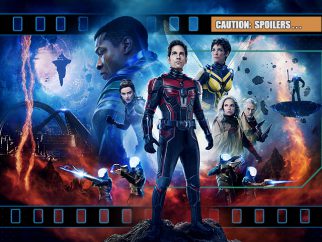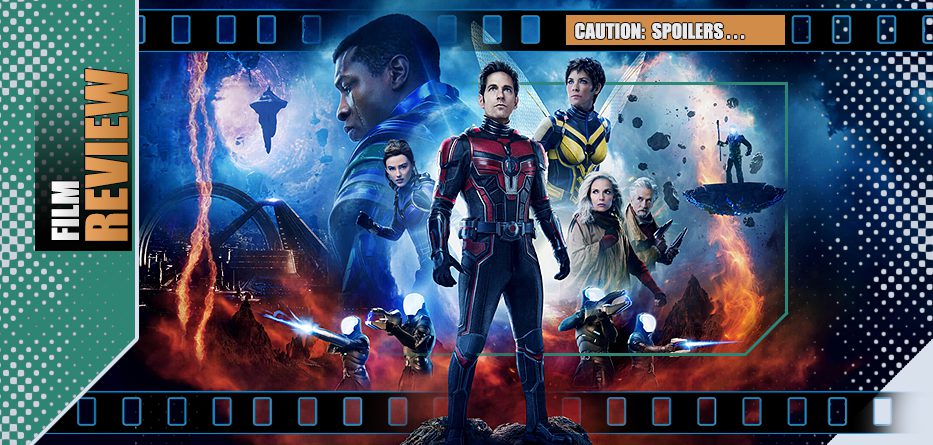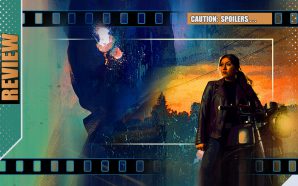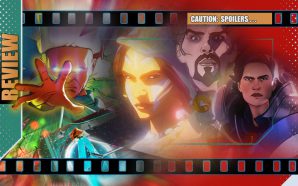In the wake of saving the universe, Scott Lang has settled into a routine of doing book-tours, being mistaken for Spider-man and despairing over his daughter following in his previous petty-crime footsteps. To be fair, her arrests are more to do with standing up for the little guys and her feeling that her father really isn’t using his powers for key social issues. But she has also been spending her time working with Hank Pym on being able to track objects in the Quantum Realm.
Janet Van Dyne is horrified – there are things she’s never revealed about her time trapped in the microverse, but before she can warm her family about them, a power-pulse sucks them down into the Quantum Realm, where Janet is forced to face some of her past decisions. The realm is full of bizarre and wonderful civilisations, but one exile has risen above it all and conquered everything he sees. His name is Kang, a man who knows far too much about the past and the future of the multiverse.
Now, the Pyms and the Langs have to face a hard truth. Saving Cassie and escaping the Quantum Realm may mean making a deal with Kang. But if they do, what will be the cost to the multiverse itself?
*spoilers*
It’s probably appropriate that the latest Marvel movie’s success relies on something very small to make a very big impact. It’s not so much Ant-Man himself, but actually the potency of the pixels – because Quantumania is so much reliant on VFX that one can only imagine how mundane the actual sets of the film must have been: essentially a menagerie of green-screens and tennis balls and director Peyton Reed shouting “Duck! Dive! Now imagine a squidgy monster with no orifices!” at his various actors.
Story-wise it’s pretty basic: The Pym-Lang family gets transported far away and has to find a way home while fighting an assortment of weird creatures and a dictator – think an askew Oz with added chromosomes. The slightly longer version: Due to messing around with some tech, Hank, Janet, Hope, Scott and daughter Cassie get sucked into the quantum realm where they discover that Janet’s thirty years in that sub-atomic universe wasn’t spent idly waiting to be rescued – she found another human-looking castaway who said he was an explorer and together they worked on a way to escape. However her new found friend turns out not to be quite as nice as he appeared and on the brink of taking off like a balloon from Oz, she realises he’s actually an evil dictator who wants to go back to conquering the universe and time and killing a host of alt-timeline Avengers (and excuses his behaviour by saying he’s averting a bigger disaster that’s yet to come). Janet sacrificed her own escape to foil his plans and stood against him… but when she was finally rescued by Hank (back in the second film) she just wanted to forget her time there, but knowing that ‘Kang’ had likely conquered the realm. Now they’re all back there, she has to decide how many of her family she can save while still keeping Kang locked up within his own kingdom so he doesn’t destroy the multiverse itself.
In recent times Marvel has specialised in the creation of the weird and wonderful that populate the various corners of its cinematic universe. Be it some alien world visited by the Guardians of the Galaxy or now the subatomic microverse of Ant-Man, there’s almost a signature subversive look to the organic globules or metallic monsters – to the ironic point of it not actually feeling as bizarre and diverse as it should, but Quantumania certainly gives the creature creation department a wide canvas on which to showcase them and then proceeds to make rather formula set-pieces at least look pretty in the moment. It’s also somewhat true of the story elements. Everything – for a film about a diminutive, self-deprecating hero – is writ large… but that’s only one measurement and it’s the depth and weight that’s missing. Sure, from the very first moment, Paul Rudd continues to capture Scott’s self-deprecating yet somehow ego-friendly hero with a lightness of touch that’s welcome. But put aside the banter and it’s all very familiar and unsurprising. Set-pieces and battles entertain but don’t quite excite as they should. To this day the climactic battle at the end of Avengers: Endgame remains a landmark piece of big blockbuster movies with it looking great, feeling great and worthy of ten years of build-up on a character-based levels. The stakes felt high. But almost every film in the aftermath, perhaps inevitably and understandably, hasn’t being able to match that… the action sequences are fun in the moment and easy on the eye, but almost interchangeable in their appearance. We’re told of their import, but it’s a carousel of ‘Punch. Splat. Quip. Move on‘. Do I care about the Pym/Langs? Of course… but it’s not until the last few minutes when it even occurs to me that we could lose any of them. (Admittedly, I thought they might actually kill or erase Scott at the end to set up higher stakes before bringing him back at some point, but no) and then they all make it home by simply pressing a button.
In many ways it feels as if this film’s entire remit is to be an introduction to Kang, but it may simply confuse the audience. It’s one thing to know that Kang, all-powerful that he is, has multiple versions of himself across the multiverse and has a date with destiny somewhere along the MCU timeline, but we seem to keep getting re-introduced to him only for the slate to be wiped clean each time. The character (or a version of him) was the Big Bad(ish) of the first season of Loki and will feature more prominently in the upcoming second season of the show (also stay after the credits of Quantumania for a tie-in to that). But in both cases – spoiler alert – the variant ends up dead and the other credits-scene in this feature film showcases such a massive arena of Kangs that it puts the multiversal Spider-verse movies to shame. Thanos was cleverly built up as this threat from the shadows, made all the menacing because of his reputation and minimal screen-time until he burst forth as an enigmatic, complex and ruthless villain. So far, it feels like Kang is his own warm-up act, appearing, posturing and then being killed and for us to be told there’s a worse version of him to come. With his final appearance being years from now in one of the listed Avengers movies (and with Endgame being the yard-stick by which all will be measured), I’m just not sure I’m feeling the rinse/repeat peril.
That’s not to say that Jonathan Majors doesn’t have real presence – he’s an excellent choice for a character that has to be quiet and sympathetic one minute and a raging tyrant the next, but though he inhabits the role and all its demands, it simply asks less and less as the movie goes on – turning a layered performance into a one-note generic villain. Equally, Michelle Pfeiffer continues to prove her veteran talents, Michael Douglas has a wry gravitas, Evangeline Lilly makes the best of an underused supporting role as Janet Van Dyne and Kathryn Newton steps in to play Cassie Lang with one eye on a possible Young Avengers role.
There are other casting elements that are harder to forgive. The MCU‘s version of MODOK turns out to be a rather stretched, contorted punchline with the revelation that the entity inside the infamous big-head-little-body hub is none other than Darren Cross (Corey Stoll), vanquished in the first film and mistakenly thought to be dead. Cross was pretty much a cackling, scenery-chewing antagonist on his first appearance and here he’s reduced to a simmering, resentful, comic-relief henchman whose sole reason for being there is to be the brunt of jokes and disdain from everyone else and whose mini-redemptive arc is simply realising how much of a pathetic ‘dick’ he really is. It’s also one of the film’s worse special effects and I think I’d rather have the animated version of MODOK that was voiced by Patton Oswalt with the universe-adjacent season on hulu. Equally, the appearance of Bill Murray (as one of Janet’s old microverse colleagues, Krylar, who has since sold-out the cause) is utterly pointless to the extent of being head-scratchingly irrelevant to anything but being a filler scene. The character makes no real sense and feels like the stunt-casting it is. Murray – playing not so much Krylar as low-energy Bill Murray – could be snipped out of the movie with a couple of slices from an editor without causing a single ripple or loss.
Better than some recent Marvel entries and acceptable as some lightweight ‘derring-do’ that’s pretending to be darker and ‘foreboding’, Quantumania is a pixel-powered placeholder that will suffice for now, but if the MCU wants to get some much-needed forward momentum, it’ll have to try a bit harder to provide something that lingers beyond the final credits scenes.

- Story7
- Acting8
- Direction8
- Production Design / VFX9











